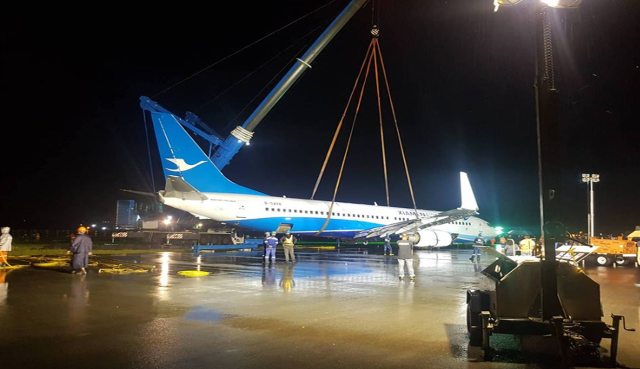Airport Shutdown: Failure to Highlight Poor Management Response

Screengrab from MIAA’s Facebook page.
A RUNWAY mishap paralyzed the Ninoy Aquino International Airport (NAIA) operations for 36 hours, inconveniencing thousands upon thousands of passengers. The incident put NAIA back in the news – once more for negative reasons – and revealed weaknesses in the response of air transport officials and the transportation department to such emergencies.
The Xiamen Airlines Flight MF8667 from Xiamen, China skidded on the NAIA runway upon landing close to midnight on Thursday, August 16, during a heavy downpour. All 157 passengers and eight crew were safe, although four sustained minor injuries. The incident forced authorities to shut down NAIA until Saturday and consequently caused flight delays and cancellations.
Media coverage gave emphasis to the woes of the stranded passengers and delayed travelers, but there was less scrutiny of the lapses in providing and coordinating government action to address the different aspects of the crisis.
CMFR monitored primetime newscasts (ABS-CBN 2’s TV Patrol, GMA-7’s 24 Oras, TV5’s Aksyon, CNN Philippines’ News Night), the three leading broadsheets (Philippine Daily Inquirer, The Philippine Star and the Manila Bulletin) from August 16 to 22.
Who Media Spoke to
Manila International Airport Authority (MIAA) General Manager Ed Monreal and Civil Aviation Authority of the Philippine (CAAP) Director General Jim Sydiongco figured in reports, providing updates on the removal of the plane. Not much was said regarding contingency plans to address the plight of passengers except to ask them to contact their airline carriers for updates regarding their flights.
MIAA manages NAIA, while CAAP implements policies on civil aviation. The two are among the 16 attached agencies of the Department of Transportation (DOTr).
Interestingly, not much was heard from Transportation Secretary Arthur Tugade, except for a statement issued by DOTr two days later on August 18 in which he apologized and said: “This incident served as an eye-opener — a reminder for us to take a second look at the processes, procedures and protocols of concerned agencies, as well as airlines, so that we may all improve in the future.”
Media also spoke to stranded passengers, many of whom were Overseas Filipino Workers (OFW) who feared for the expiration of their visas. Lawmakers calling for a probe on the incident were also quoted.
Bigger Issue
As media reported on stranded passengers, canceled flights and apologies from DOTr, MIAA and Xiamen Airlines, it also revealed NAIA’s incapacity to deal with emergencies evident in the lack of contingency plans. Although some flights were diverted to Clark Airport in Pampanga, these also encountered problems due to lack of adequate facilities there. Monreal also said that airlines mounting recovery flights did not coordinate with MIAA, causing more problems. But that should have been anticipated by MIAA which should have given early instructions about such requirements.
Some reports noted that NAIA is operating beyond its capacity level. But the operational weaknesses of the country’s major airport cluster have been long established. So the media should have focused on the failure of those in charge to anticipate this kind of emergency.
Overall, the incident revealed the level of incompetence that characterizes the Transportation Department. This was best articulated by the Philippine Daily Inquirer in its editorial “Airport anarchy” published Thursday, August 23.
“The incident not only exposed dangerous weaknesses in the country’s air transport system, it also puts into question the capability of air transport officials to handle and respond to such emergencies,” the editorial said. Unfortunately, news accounts seemed unwilling to scrutinize the failure of governance in these areas.
What’s even more telling is that this is not the first incident at NAIA which inconvenienced passengers. In 2017, absences, resignations and leaves by Immigration employees resulted in nightmarish queues of arriving and departing passengers (see monitor: “Covering Immigration Woes”).
Cheer
CMFR CHEERS Aksyon’s explainer on the layout of NAIA which showed how one plane shut down airport operations.
Tracing the airport’s beginnings as the Nichols Air Field of the US Army Air Corps before World War II, anchor Ed Lingao observed that NAIA retained the two-intersecting runway layout and said it is obsolete and problematic because any issues occurring at the intersecting point could completely paralyze the two runways. He also noted that NAIA only has one runway for international flights.
The explainer also looked at airports located in Hong Kong, Jakarta, Indonesia and Kuala Lumpur, Malaysia and showed a more modern layout, with three or more parallel runways. Ending the explainer, Lingao noted plans of the government to develop airports in Sangley Point in Cavite and in Bulacan.
Such background information on NAIA help viewers understand the problem, making clear that coordination of response efforts when such a crisis occurs should be established by officials in charge.
Leave a Reply